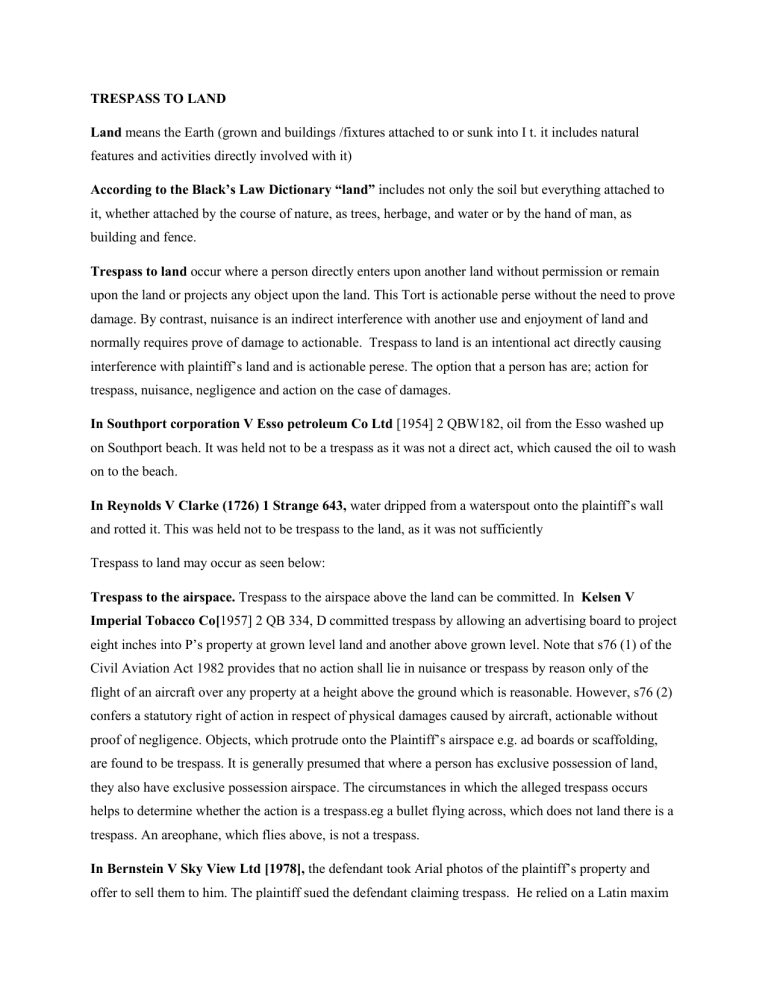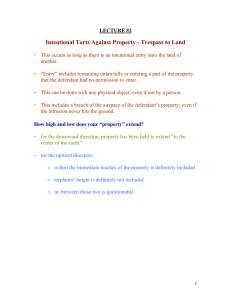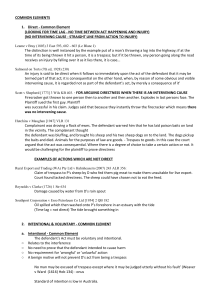
TRESPASS TO LAND Land means the Earth (grown and buildings /fixtures attached to or sunk into I t. it includes natural features and activities directly involved with it) According to the Black’s Law Dictionary “land” includes not only the soil but everything attached to it, whether attached by the course of nature, as trees, herbage, and water or by the hand of man, as building and fence. Trespass to land occur where a person directly enters upon another land without permission or remain upon the land or projects any object upon the land. This Tort is actionable perse without the need to prove damage. By contrast, nuisance is an indirect interference with another use and enjoyment of land and normally requires prove of damage to actionable. Trespass to land is an intentional act directly causing interference with plaintiff’s land and is actionable perese. The option that a person has are; action for trespass, nuisance, negligence and action on the case of damages. In Southport corporation V Esso petroleum Co Ltd [1954] 2 QBW182, oil from the Esso washed up on Southport beach. It was held not to be a trespass as it was not a direct act, which caused the oil to wash on to the beach. In Reynolds V Clarke (1726) 1 Strange 643, water dripped from a waterspout onto the plaintiff’s wall and rotted it. This was held not to be trespass to the land, as it was not sufficiently Trespass to land may occur as seen below: Trespass to the airspace. Trespass to the airspace above the land can be committed. In Kelsen V Imperial Tobacco Co[1957] 2 QB 334, D committed trespass by allowing an advertising board to project eight inches into P’s property at grown level land and another above grown level. Note that s76 (1) of the Civil Aviation Act 1982 provides that no action shall lie in nuisance or trespass by reason only of the flight of an aircraft over any property at a height above the ground which is reasonable. However, s76 (2) confers a statutory right of action in respect of physical damages caused by aircraft, actionable without proof of negligence. Objects, which protrude onto the Plaintiff’s airspace e.g. ad boards or scaffolding, are found to be trespass. It is generally presumed that where a person has exclusive possession of land, they also have exclusive possession airspace. The circumstances in which the alleged trespass occurs helps to determine whether the action is a trespass.eg a bullet flying across, which does not land there is a trespass. An areophane, which flies above, is not a trespass. In Bernstein V Sky View Ltd [1978], the defendant took Arial photos of the plaintiff’s property and offer to sell them to him. The plaintiff sued the defendant claiming trespass. He relied on a Latin maxim which stated that the owner owned the land “ up to the heaven and down to hell” Lord Griffiths disagreed with this, stating that in order to determine the height of airspace one needs to look at what is necessary for owner’s enjoyment. He thus stated that; “this balance is in my judgement best track in our present society by restricting the right of an owner in the airspace above his land and the structure upon it” Entering upon land. Walking onto land without permission or refusing leave when permission has been withdrawn or throwing object onto land are all examples of trespass to land. In the case of Esso Petroleum V South cooperation the defendant were held liable in trespass to land for allowing oil from his or her own land to enter the plaintiff’s land Trespass to the grown. In Bulli Coal Mining Co V Osborne [1899] AC 351, the Ds mine from their land to the P’s land. It was held to be trespass to the subsoil. Elements to trespass to land includes: Entry onto the land by a person/ animal or placing the object into the land Esso petroleum V south cooperation the defendant were held liable in trespass to land for allowing oil from their own land to enter the plaintiff’s land. Defendant had no justification. Elias V Pass more. Police officers who entered the plaintiff’s premises to affect an arrest and seized documents were held liable as trespassers abinitio because what they did is not what they had permitted to do on the land. Defendant entry was intentional. Plaintiff must prove that he was in possession of the land, which the defendant entered in Sheikh Muhammed Lubowa V Kitara Enterprise Ltd CA No.4 of 1987 observes that one must prove: That the dispute land belongs to the plaintiff That the defendant had entered upon it and That entry was unlawful in that it was made without permission or that the defendant had no claim, right, or interest in the dispute land. In conclusion, Tort developed to protect a person’s possession of land, and so only, a person who has exclusive possession of land may sue. Thus, a landlord of Leased premises does not have exclusive possession nor dose a lodger or a licensee. However, a tenant or subtenant does as seen in the case of Street V Mountford [1985] 2 All ER 289.


